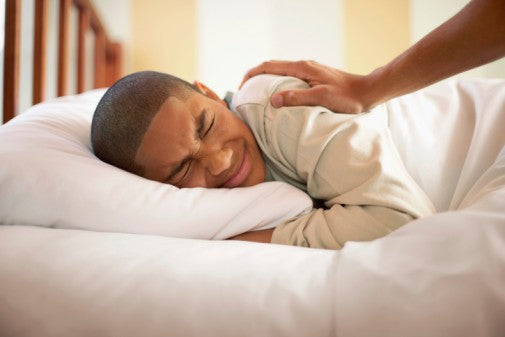Teen Rx

Take two dreams and call me in the morning.
By Brian Thornburg, MSM, DO, FAAP
Sleep is an ever-changing curiosity. Infants and children fight it, teens
can’t avoid it, and adults crave it. But why so much sleep during the
teen years when they arguably have the most energy and the
willingness to stay up all day and night?
Teens sleep whenever because they can. They are busy, they live in
their room, and they have the freedom of youth. ‘I can therefore I will’
is an unspoken adolescent maxim. But sleep is more than the quiet
moments between todays; it is the Rosetta Stone to emotional
processing. Dreams are not just earplugs keeping them from waking
up.
This article is about those in-between moments when the lights go
out and a transcendent behind-the-scenes world begins. When the
backsides of the eyelids become mystical operatic glasses to an epic
healing adventure.
A teen’s mammoth sleep is actually a matter of perception. Teens
sleep while we are awake and are awake when we sleep. They
average two to two-and-a-half fewer hours of sleep a night than
recommended by the medical community. That is, they are not
sleeping as much as we think or as much as they need. Teens are
more zombies with emotional-dysregulation sleep-deprivation
syndrome than slumbering sloths with smart phones.
Let’s review a typical teen day. High school starts at 7:05am so they
wake at 6am. After school most kids participate in sports and clubs
and many have jobs as well. At some point they study and have a
social life. They are after all the central actors in their own personal
John Hughes drama (think Breakfast Club and Sixteen Candles.) By
the end of the day only seven to seven-and-a-half hours remain for
sleep before the cycle starts again. Teens need more than nine hours
of sleep a night.
So what is this iota sleep deficit doing to our teens? Could this be the
reason we live with explosive, demanding, and dramatic Freddy
Kruegers instead of polite, considerate, and grateful Richie
Cunninghams?
I have three teens now and in a few years will have five under roof.
You better believe I am interested in distinguishing sleeping from
waking moments! I want my potential nightmare to be a pleasant
dream.
The subconscious uses sleep to process our waking experiences
using archetypal constructs to allow us to absorb universal patterns
and images that are part of the collective unconscious. Wow, did I
really just write that? What I meant to say is sleep is good. Life heals
in these sleeping moments.
The Sleep and Neuroimaging Lab at the University of California at
Berkeley published a 2011 study that proposed a link between our
dreams and emotions. A reduction in REM sleep (less “dreaming”)
influences our ability to understand complex emotions in daily life.
Sleep helps us get along with others and is an essential feature of
human social functioning.
Dreams help us process emotions by translating and assembling
memories of them. What we see and experience in our dreams are
not be real, but the emotions attached to these experiences certainly
are. Our dream stories essentially try to strip the emotion out of a
certain experience by creating a memory of it. This way, the emotion
itself is no longer active.
This mechanism fulfills an important role because when we don’t
process our emotions, especially negative ones, this increases
personal worry and anxiety. In fact, severe REM sleep-deprivation is
increasingly correlated to the development of mental disorders. In
short, dreams help regulate traffic on that fragile bridge which
connects our experiences with our emotions and memories.
So how do we turn a Nightmare on Your Street into Happy Days? By
REMming our motors to an all night creature feature!
Here is a breakdown of how much sleep is needed:
Newborns (0-3 months): Sleep range is ~15.5 hours.
Infants (4-11 months): Sleep range is ~13.5 hours.
Toddlers (1-2 years): Sleep range is ~12.5 hours.
Preschoolers (3-5): Sleep range is ~11.5 hours.
School age children (6-13): Sleep range is ~10 hours.
Teenagers (14-17): Sleep range is ~9 hours.
Younger adults (18-25): Sleep range is ~8 hours.
Adults (26-64): Sleep range is ~8 hours.
Older adults (65+): Sleep range is ~7.5 hours.
So when you walk into your teen’s bedroom and scratch the dream
record by yelling, "It’s 6:00am. Time for school!” remember your
house is like a fragile coral reef with different species coming out
depending on the time of day. Daytime is only half the story. Nightly
sleep isn’t the curtain call to a show that mustn’t go on/ Slumber is
the Freudian visitor you welcome as the bedroom drifts into a sea of
epic healing adventures.


Leave a comment